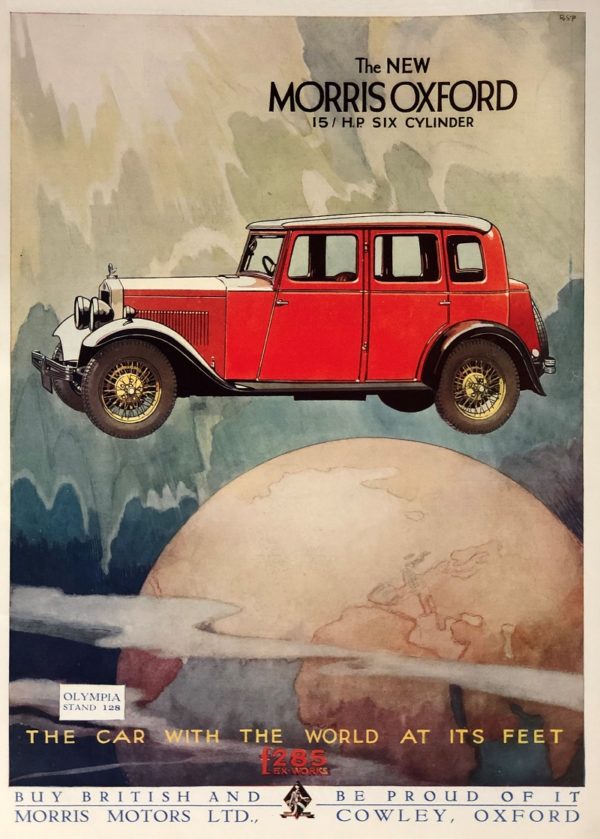
We chose this week’s Snapshot for the remarkable imagery of the advertisement, rather different from the more conventional publicity illustrations by Morris and its competitors from this era with their images of cars in urban or country settings with drivers and passengers.
Another striking element of the illustration is the stylish fabric bodywork. This was apparently only offered on the Oxford from 1929 to 1932, the remaining bodies being in steel.
The advertisement appeared in The Illustrated London News Motor Supplement for 19 October 1929 and contained two other interesting elements apart from the image. The first was the strapline: “The Car with the World at its Feet” – a clear implication that Morris considered this to be an important new model for them, worthy of a full-page colour advertisement. The second was a sign of the times: the words “Buy British and be Proud of It”. During the 1920s and 1930s many British companies participated in campaigns to encourage shoppers to buy goods from the UK or other parts of the empire, and the motor industry was no exception. Rolls-Royce used a similar exhortation in their advertisements from 1935 until World War II, but Morris were doing this at least five or six years before.
There were many Morris models in this period, making it difficult to isolate the one in our Snapshot. Indeed, one source states: “For other contemporaneous cars loosely named Morris Six see Morris Ten, Morris Major (1931 to 1933), Morris Fourteen Six, Morris Cowley, Morris Fifteen Six, Morris Six (1928), Morris Six MS, Morris Isis, Morris Twenty-one Six, Morris Twenty Five Six.”
Fortunately, there is one unimpeachable source where “our” car appears: a road test in The Times for 15 October 1929, four days before this advertisement.
The report opened with an opinion shared with us about the appearance of the fabric -bodied car:
“The 15 h.p. Morris-Oxford Six five-seated fabric saloon is a well-proportioned car inside and out and comfort has been studied.
“The body has the fashionable sloping lines and no valances; the doors are taken down to wide running boards. The seating is well arranged for room and head clearance.”
The test report continued its positive theme with such phrases as “Safety glass is fitted”; “Door catches and locks are convenient”; and “… built into the body is a fair-sized luggage compartment.” There was a small criticism sandwiched between more praise: “Entrance to the rear is fair – one’s coat is apt to brush the wings – that to the front seats is commendably free, the sloping of the doorways greatly helping toe room.”
The report also gave technical details: a side-valve six-cylinder engine of 1,938cc, with minimum b.h.p. of 45 at 3,200 r.p.m, a three-speed gearbox, hydraulic shock-absorbers and Lockheed hydraulic brakes. This was not a fast car: speeds reached in the road test were 20, 40 and 60 mph in the three gears. But the overall impression from the test was one of a competent machine at a competitive price of £285 for this smart fabric saloon.
Picture courtesy of the Richard Roberts Archive







Leave a Comment